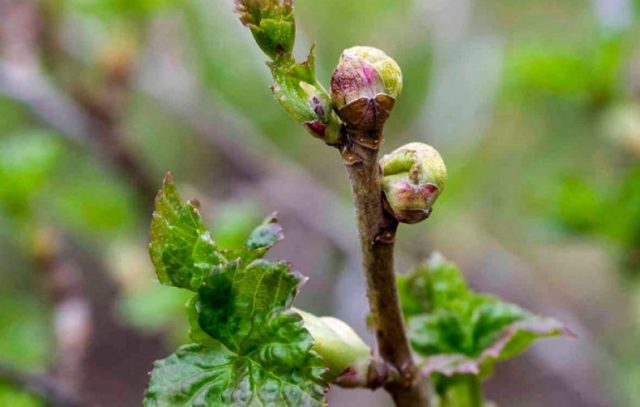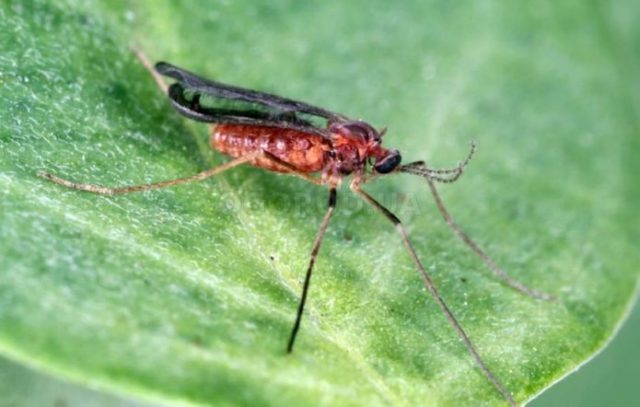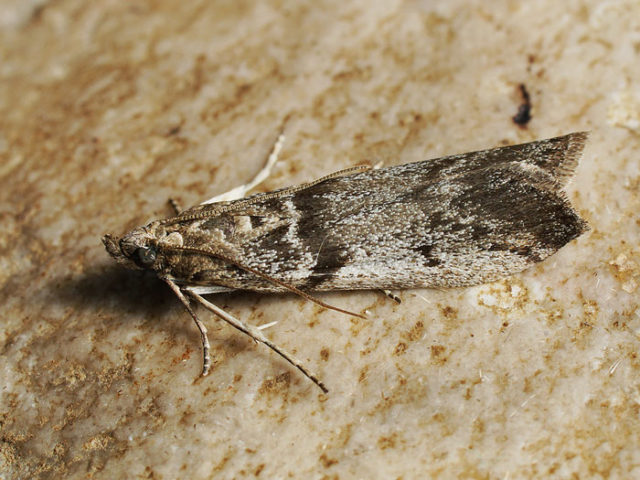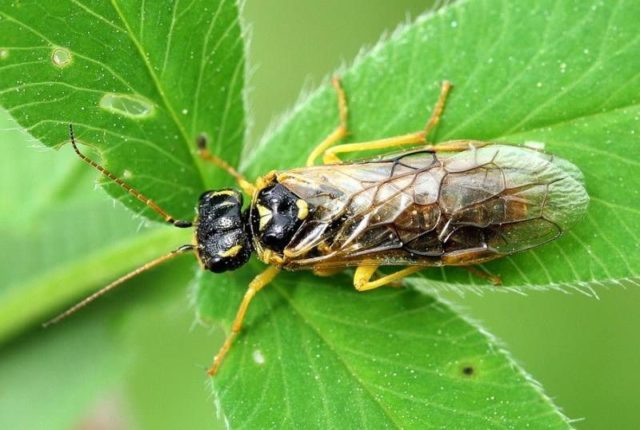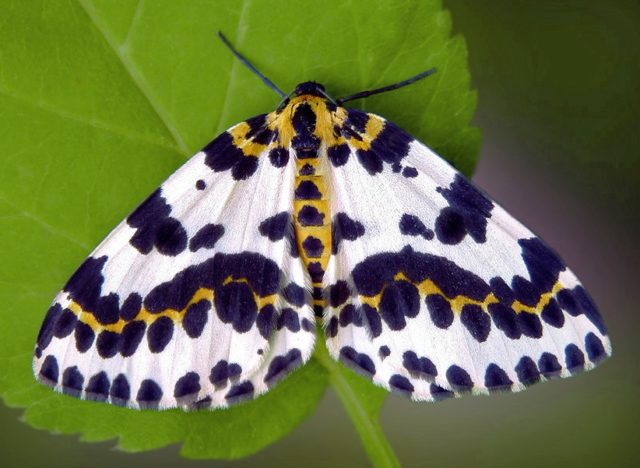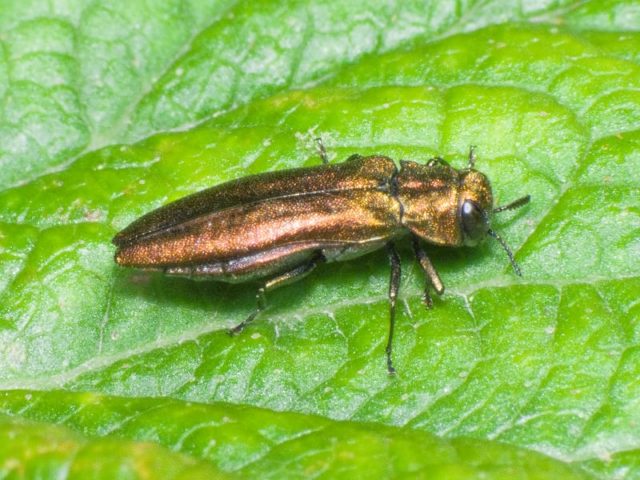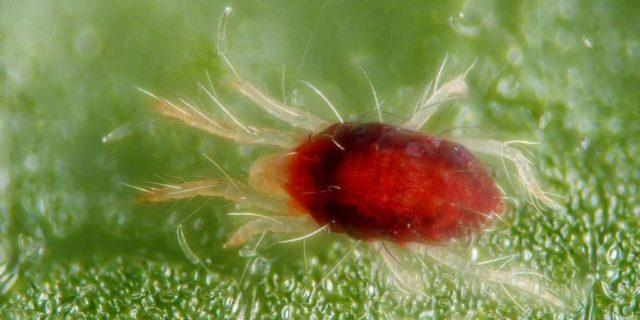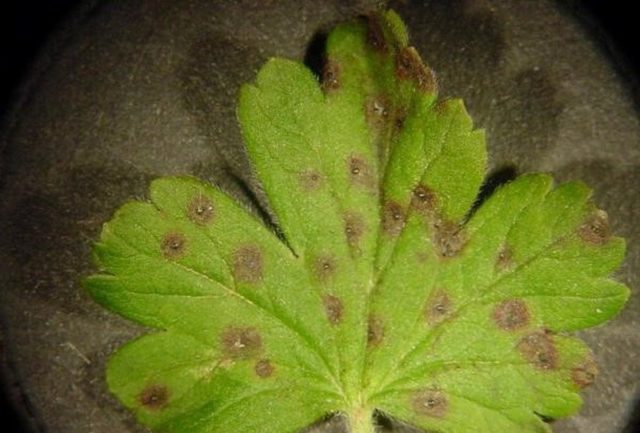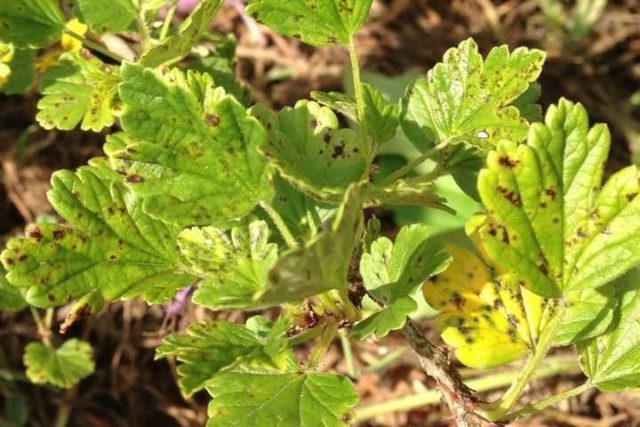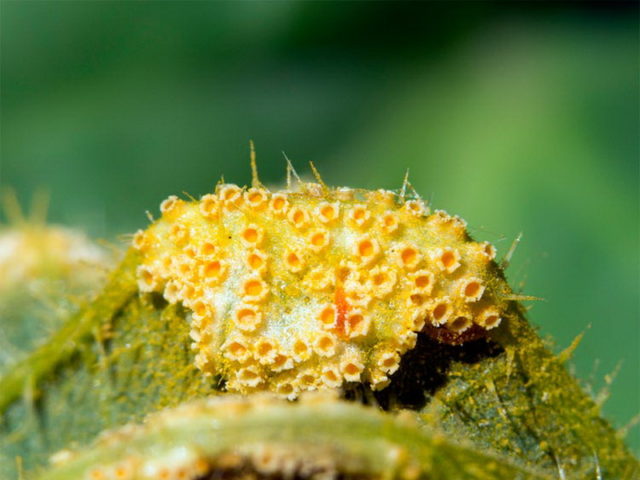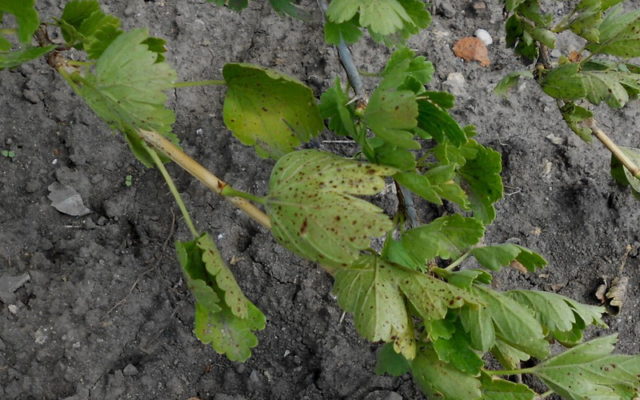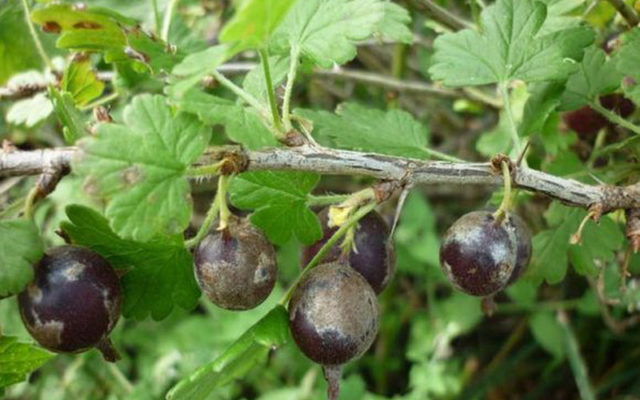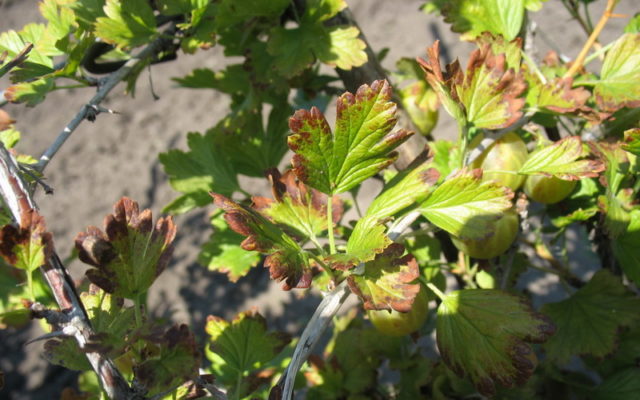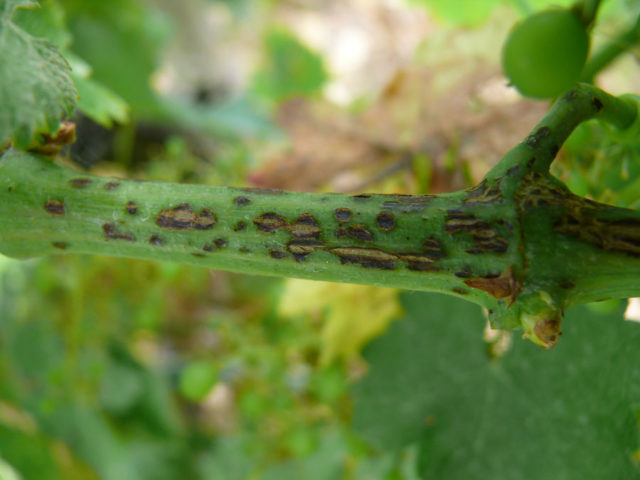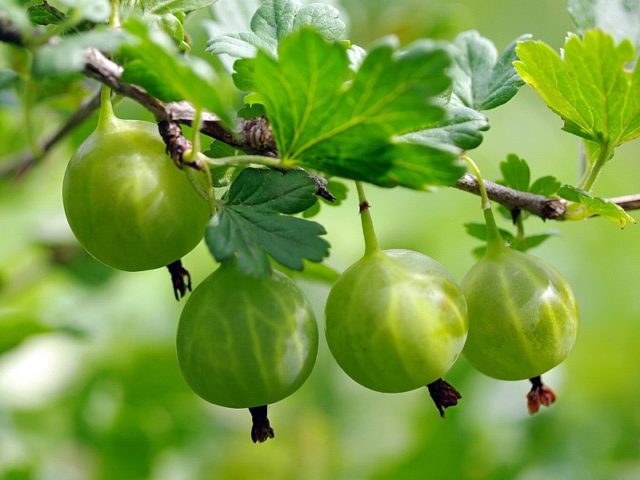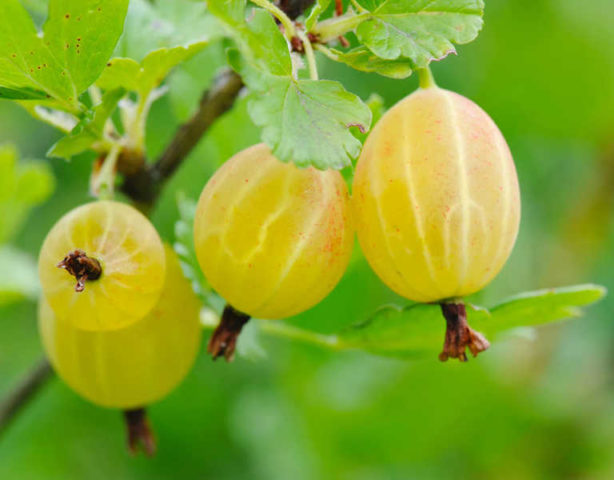Content
Diseases of gooseberry berries can destroy even the strongest fruit bushes in the garden. To keep gooseberries healthy and strong, you need to know the symptoms of diseases and pests and effective control and prevention measures.
Gooseberry pests with a description and photo
Gooseberry bushes in the garden quite often infect pests, especially insects often appear on the plant in the absence of careful care. However, each of the pests can be successfully dealt with if you study the photos of gooseberry pests and the fight against them.
Sprout aphid
The shoot aphid pest feeds on young shoots and leaves of the plant. The size of the insect does not exceed 2 mm, the adult aphid has a pale green color and a slightly elongated body shape. In autumn, the shoot aphid lays black small eggs at the base of the buds, and larvae appear from them in early spring.
The peak of the defeat of gooseberry by shoot aphids occurs in May and June, however, several generations of the pest may appear during the season. Aphid-infested plants can be recognized by deformed internodes and curled leaves. The plant on which the aphid has bred loses its vitality, the leaves begin to dry and fall off.
To eliminate aphids, proven insecticidal agents are used - Karbofos, Actellik, Vofatox. The plant is sprayed in the spring, even before the buds open, to prevent the aphid larvae from penetrating into the shoots.
Kidney mite
The microscopic pest does not exceed 2 mm in size and resembles a very small white worm. The tick hibernates inside the gooseberry buds, and it affects the shrub very massively - several thousand larvae can settle in one bud. Symptoms are expressed in the fact that the buds are strongly rounded, swollen, and the next year after settling they begin to resemble burst small cabbage heads. For a year, a kidney mite gives 2 spring and 3 summer generations, if you do not fight it, then the pest greatly interferes with the development of the plant and worsens the yield.
The fight against kidney mites is carried out with acaricidal solutions - Topaz, Skor, Vitofors. It is also necessary to completely remove the affected kidneys.
Currant gall midges
The pest resembles a mosquito about 3 mm long and lays translucent small eggs under the bark of the stems, from which colorless caterpillars about 4 mm in length emerge. The pest feeds on the soft juicy tissues of young stems, which is why the shoots darken, dry out and crack, and the leaves turn yellow and fall off. The gall midge begins to feed on the plant in the spring, and the mass release of adult insects from the larvae occurs at the beginning of flowering.
In the fight against gall midge, gardeners prefer to use insecticidal agents and folk methods, for example, soapy water in combination with steamed tomato tops. You can also plant mint next to the gooseberry bushes - the gall midge does not like its smell.
Currant glass
This pest resembles a small dark butterfly, reaching about 3 cm in wingspan. The glassworm lays eggs in the cracks in the bark of the branches, and the larvae of the pest, white caterpillars, feed on the wood of the shoots. The first 2 winters, the larvae spend inside the branches and eat off, only in the third year insects emerge and pupate, and adult butterflies appear in June.
The harm of the glass for the gooseberry is expressed in the wilting of the shoots and the appearance of black spots on the cuts of the dried branches. Insect control is carried out using radical pruning in order to completely eliminate the affected parts of the plant.
Caterpillars
Caterpillars of a wide variety of pests on gooseberry leaves appear in early spring directly during the period of bud opening. During the season, 2-3 generations of caterpillars may appear. You can notice the pest when inspecting the leaves, and the harm is that the caterpillars are able to completely devour the foliage of the bush.
The fight against the pest is carried out mainly with the insecticides Karbofos and Actellik; it is recommended to spray after bud break and again after flowering. If caterpillars are found after harvest, the processing will need to be carried out a third time.
Fire
The gooseberry pest, the moth, looks like a green caterpillar with a black head or a dark brown butterfly up to 3 cm in wingspan. The moth lays eggs in gooseberry flowers in spring, after which caterpillars appear from the clutch, which settle in the gooseberry ovaries and eat them away. A characteristic sign of fire damage is the thinnest cobweb on the gooseberry fruit.
The harm to the plant lies in the fact that the berries ripen ahead of time, and then quickly dry out. Firefighting is carried out by Karbofos, Aktellik and Ambush, and gooseberries are sprayed after flowering and immediately in front of it next year.
Sawfly
The pest is a bluish-green larva up to 1 cm long, of which adult butterflies appear at the beginning of flowering in spring. In turn, they lay eggs on the underside of the leaves, and after about 1.5 weeks, caterpillars appear from the eggs, which begin to eat the leaves of the bush. As a result, the plant loses its foliage, the shoots begin to grow worse, the berries become smaller and fall off.
The fight against the sawfly is carried out with insecticidal solutions, if there are currant bushes next to the gooseberry, they must be treated too, the pest usually settles on several plants at once.
Moth
The pest is a large spotted butterfly up to 5 cm in wingspan. The pest caterpillars appear in early spring, as soon as the gooseberry buds. In the middle of summer, adult butterflies form from the caterpillars, which again lay eggs on the underside of the gooseberry leaves. In just 2 weeks, a second invasion of the pest occurs on the shrub, this time the caterpillars eat the leaves.
The pest of gooseberry leaves, the moth, causes significant damage to the decorativeness and health of the plant, leading to its wilting and drying out. The fight against the moth must be carried out with the help of Actellik and Karbofos.
Currant goldfish
A small bug, reaching several centimeters in length, lays the larvae inside the gooseberry shoots, and at the beginning of summer, the adults that appear once again lay eggs on the bark and young leaves. The larvae of the gooseberry eat the buds and foliage of the gooseberry, and also gnaw through the passages inside the shoots, as a result of which the gooseberry stops growing and bearing fruit.
As part of the fight against the pest, all affected branches must be completely removed, even if the currants have to be cut at the root.
Spider mite
Among the pests of gooseberries and the fight against them, the spider mite is especially known, which has a brown, yellow or green color. The pest lays eggs on the leaves from below and actively eats gooseberry foliage. It is easy to recognize a spider mite by the presence of a characteristic thin cobweb on the lower part of the leaves. If the plant is severely affected, then its foliage eventually becomes "marble", dries up and falls off, the gooseberry loses its winter hardiness, and its yield decreases.
The fight against spider mites is carried out in the spring during the budding period, and the best effect is given by solutions of Karbofos, Phosphamide, Metaphos and Cydial.
How to spray gooseberries from pests
Insect control is usually carried out in early spring, as soon as the temperature rises above 5 ° C. The optimal period for spraying the plant is from mid-March to mid-April, and for preventive purposes, gooseberries can be re-processed immediately after they have bloomed.
- Of the chemical agents for pest control, Actellik and Karbofos are most often used; Vitofors, Phosphamide and other insecticidal preparations are also popular.
- Soap and onion solutions, as well as colloidal sulfur, help well from home remedies.
- It is recommended to spray gooseberries in cloudy weather without rain. Precipitation can instantly wash off insecticidal agents from the leaves of a bush, and the sun dries out solutions too quickly and does not allow them to show their beneficial effect.
When fighting insects with insecticides, it is important to pay attention to personal protection - wear heavy gloves and a respirator, protect your eyes and nose so as not to inhale toxic substances. It is necessary to carry out the fight in work clothes, which are thoroughly washed immediately after spraying.
Diseases of the gooseberry bush, leaves and berries with a photo and description
Not only pests, but also ailments - fungi and viruses can negatively affect the health of the gooseberry. In order to cure the shrub in time, you also need to know gooseberry diseases and their treatment, ways of spreading and symptoms.
Spheroteka
Disease of gooseberries with white bloom on berries - spheroteka, or powdery mildew, it affects the shrub most often. The disease is caused by the fungus Sphaerotheca, which develops especially actively in warm and humid conditions. The main symptoms of the disease are a whitish bloom on the leaves, which becomes denser over time, affects the ovaries and fruits, and leads to premature shedding of fruits.
The fight against the disease is carried out with the help of Bordeaux liquid and copper sulfate, you can also use a solution based on tar soap.
Anthracnose
Another disease that leads to the appearance of mold on gooseberries and to leaf deformation is anthracnose. The disease is caused by a fungus of the genus Colletotrichum, which spreads to the plant from the soil. At first, small brown specks on the leaves become the symptoms of the disease. Subsequently, anthracnose leads to the fact that the leaves of the gooseberry turn completely brown, and the fruits become covered with dark mold.
The fungus reproduces mainly in the rainy, warm months. To combat it, you need to remove all affected parts from the gooseberry and treat the bush with Bordeaux liquid, Kuprozan, colloidal sulfur and other fungicidal substances, and the disease is treated in early spring.
Septoria
Septoria disease is caused by the fungus Septoriaribis Desm and manifests itself primarily as gray spots with a dark border on gooseberry leaves. Then microscopic fruiting bodies of the fungus appear on the spots, which look like dark dots.The gooseberry leaves begin to dry, deform and fall off, and in one summer the shrub can completely lose its crown. The fungus spreads from the spores that have appeared in the ground at the roots of the gooseberry and, if untreated, can destroy the plant.
The fight against the disease is carried out with the help of fungicides - Bordeaux liquid and copper sulfate. It is also necessary to remove all affected parts of the shrub and clear the ground at its roots.
Rust
Fungal disease rust appears on gooseberries most often when shrubs are close to cedars or sedges. The disease is manifested by the appearance of yellowish pads on the underside of the leaves, on flowers and fruit ovaries, in these pads a fungus forms. Over time, rust forms a dense dark coating on the leaves and fruits, as a result of which the gooseberries begin to fall off and bear fruit worse.
To combat the disease, spraying with Bordeaux liquid and other fungicides is used. In this case, the treatment must be carried out three times - after the appearance of the leaves, during the budding period and immediately after flowering.
Gray rot
Disease gray rot, or scab, appears due to the fungus Botrytiscinerea and affects the lower shoots and roots of the gooseberry. The berries of the bush are first covered with a gray bloom, and then they begin to rot and crumble, the health of the plant is greatly deteriorating.
Gray rot occurs most often in conditions of neglect of the gooseberry and poor ventilation of its shoots. The disease can manifest itself at any time during the spring and summer. The disease lends itself well to treatment, but to heal the shrub, you will have to cut off all the diseased parts, and pour charcoal under the roots.
Ascochitosis
The ascochitis disease is provoked by the fungus Ascochytaribesia Sacc, which multiplies in plant debris under the roots of the gooseberry. The ailment is mainly affected by the leaves of the plant - in the spring, whitish or light brown spots with a dark border appear on them, and by the fall dark growths are formed - fruit bodies in which the fungus hibernates. Gooseberries, affected by ascochitosis, begin to dry out and fall off, and their frost resistance and yield decrease.
To combat ascochitis, you need to cut off all parts of the shrub that have already been affected by the disease. Healthy leaves and shoots are sprayed with Bordeaux liquid and other fungicides.
Verticillary wilting
The verticillium disease is caused by spores of a fungus from the genus Verticillium, and the symptoms of the disease are manifested in the defeat of the gooseberry roots. Against this background, the leaves of the plant turn yellow and wither, but they do not fall off, but remain on the bush. Verticillosis in the initial stages proceeds almost imperceptibly, and then develops very quickly. If you do not carry out emergency treatment, the shrub will die completely, the fungus will gradually rise along its shoots, clogging the vascular system, and will not allow the plant to receive nutrients.
The treatment of the shrub from verticillosis consists in the fact that the plant is sprayed with the formulations of Fundazol or Topaz. It is important to observe prevention - regularly trim and fertilize the shrub, monitor the cleanliness of the soil around it.
Mosaic
Mosaic refers to viral diseases of the gooseberry - it can spread to the plant from other fruit bushes, and aphids often become the cause of mosaic infection. In the photo of the treatment of gooseberry diseases, you can see the symptoms - bright pale yellow patterns appear on the leaves of the bush, which run along the main veins. If the mosaic is not treated, then over time, the leaves begin to dry and become covered with wrinkles, the gooseberry will cease to bear fruit and will stop developing.
It is very difficult to cure the mosaic - chemical and home remedies hardly help against the disease.The only treatment option is to remove all affected parts of the shrub and further carry out regular treatment from pests that can carry the disease.
Alternaria
The disease is caused by the fungus Alternaria grossularia Jacz and affects not only leaves, but also shoots and gooseberry fruits. The first symptoms of Alternaria are gray-black spots that appear in spring at the edges of leaf plates, and by autumn a black-green velvety bloom appears on the leaves and shoots. The gooseberry leaves begin to dry out and fall off, the shrub weakens and becomes less resistant to cold. Alternaria most often gets to the plant from plant residues on the surface of the soil, in which the spores of the fungus develop.
Alternaria is treated with Bordeaux mixture before flowering and after fruiting. It is also important to remove fallen leaves and other plant debris in time from the area where the gooseberry grows.
Drying of shoots
The disease is of fungal origin, and the spores of the fungus usually get on the gooseberry from the uncleared ground, on which the remains of foliage and small twigs lie. The disease affects the bark of the plant, it becomes less elastic and becomes covered with cracks, in which, over time, small rounded growths of black color appear, representing the actual body of the fungus.
Treatment of the disease is carried out by radical pruning of all diseased parts, and gooseberries must be treated with copper sulfate and Bordeaux liquid.
How to treat gooseberry disease
Any disease of the gooseberry must be treated urgently to prevent the death of the plant. Typically, processing is carried out by the following means:
- copper sulfate and garden var;
- Bordeaux liquid and Fundazole;
- manganese sulfate;
- iron and copper chloroxide;
- zinc and boric solutions.
Home remedies are also popular, such as tar soap, soda ash, lye, and ash, to remove a variety of fungi.
Treatment of plants from fungus can be carried out throughout the warm season - from spring to autumn. Particular attention should be paid to prevention and treatment during bud setting and flowering. But during fruiting, gooseberries should not be sprayed - chemical and toxic substances can make the fruits of the shrub unsuitable for eating.
It is customary to carry out the processing on cloudy days so that the medicinal solutions from the leaves and shoots do not wash off the rain and do not dry out the sun. It is necessary not only to spray the leaves and shoots of the gooseberry, but also to spill the soil around it with medicinal solutions in order to protect the roots from diseases.
Preventive treatment of gooseberries from pests and diseases
Fighting gooseberry pests and diseases is largely about prevention - protecting a plant from diseases and insects is much easier than curing it. In the process of growing a plant, the following preventive measures must be observed:
- regularly dig up and loosen the ground at the roots;
- remove all plant residues from the soil in a timely manner;
- pruning weak and broken branches annually, it is customary to burn all removed parts of the plant;
- Examine gooseberries regularly for any pests or fungal symptoms.
Every spring and autumn, the plant must be preventively sprayed with Bordeaux liquid or mullein infusion, it is useful to add a solution of wood ash to the soil, all these substances eliminate fungi and insect larvae in the early stages.
How to treat gooseberries in spring from diseases and pests
Spring treatment of gooseberries and currants from pests and ailments involves the use of the following chemical and natural remedies:
- Prophylactin;
- copper sulfate mixed with urea;
- ammonium nitrate;
- infusion of wormwood or tobacco;
- Aktofit and Aktellik;
- Skor and Topaz.
In addition to spraying gooseberries in the spring from pests and diseases, before the buds appear on the branches of the gooseberries, boiling water can be treated. To do this, boiling water is poured into ordinary watering cans and each bush is abundantly irrigated, making sure that hot water gets on all the shoots of the plant. Boiling water will not harm the roots of the gooseberry, as the ground is still cold and hot water only penetrates into the top layer. But the larvae of pests and fungal spores will not survive the heat treatment of gooseberries in the spring from diseases and pests.
How to treat gooseberries from pests and diseases in the fall
Since many pests and fungal ailments infect gooseberries in the summer and appear only the next year, it is recommended to carry out the autumn processing of the plant. It is carried out after the leaves have fallen off, and usually a 5% solution of baking soda, a 3% solution of ferrous sulfate and a 1% solution of Bordeaux liquid are used.
Also in autumn, gooseberries can be treated with Karbofos, infusion of wood ash, or homemade infusions of garlic and onion peels. Before the onset of winter, it is especially important to clear the soil around the gooseberry, burn all plant residues and mulch the soil with a dense layer of peat.
Conclusion
Diseases of gooseberry berries are mostly treatable, but it is very important to notice ailments or insect pests in time. It is recommended to regularly inspect the gooseberry bushes for damage, and if pests or fungi are found on the leaves, immediately spray them with proven agents.

